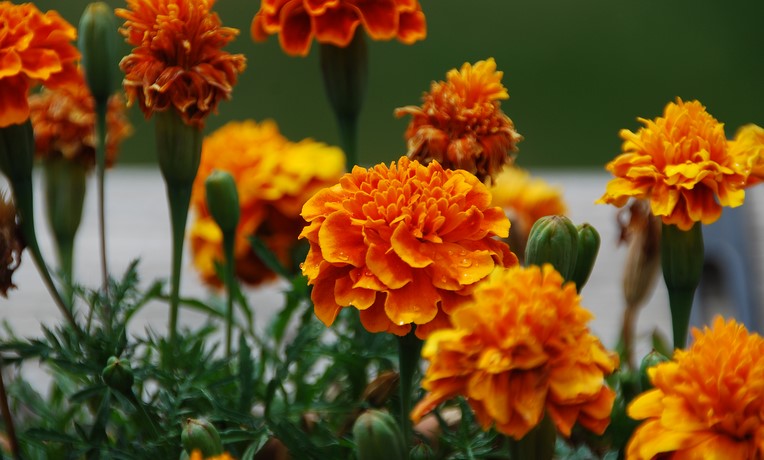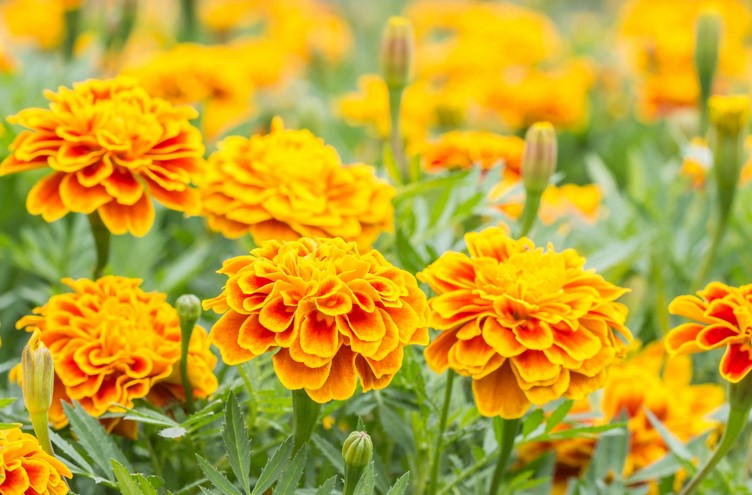
Types of Marigolds
admin
- 0
Marigolds are a group of plants in the genus Tagetes. Carl Linnaeus first described them in 1753. The marigold is also known as the signet marigold. There are many types of marigolds. In this article, you’ll learn about the different varieties, their uses, and some of their names.
Marigolds, also known as Guernsey lilies, are a beautiful flower. There are numerous types of marigolds with flowers in all shapes, sizes and colors. According to Flowers of the World by W.V. Crundall and Derek Fell, there are over 400 varieties of marigold blossoms. The flowers can be orange, yellow, red, gold, copper, brass, white or any combination of those colors. Marigolds have been cultivated for centuries because of their Spanish origin and long lasting blooms. Foliage has a distinct odor that deer and rabbits tend to avoid, making marigolds great companion plants to other plants in order to deter pests. There are three main types of marigolds: French, African and Signet

Marjoram is a signet marigold
Table of Contents
ToggleSignet Marigolds are a popular edible flower that produces a lemon-verbena- like fragrance. These flowers require full sun and produce mounds of lacy foliage topped with small yellow and orange flowers. Marigolds are fairly drought-tolerant and deer-resistant.
Calendula is a signet marigold
Calendula is a plant that is part of the Tagetes genus, which is composed of at least 50 species. Calendulas are similar to marigolds but have very distinct features. They are small and short, and have a sticky texture on the stem and leaves. Their seedheads are full of straight black seeds. The flower heads are generally edible and can be used to add flavor to dishes.
Tagetes lucida is a signet marigold
Signet Marigolds are edible, attractive flowers that are easy to grow in pots, gardens, or landscapes. They are native to Central and South America and southwestern United States. Their flowers have a licorice-like scent. The petals are sometimes used to flavor teas and salads. They are also low maintenance and attract butterflies.
Disco Orange is a signet marigold
The Disco Orange Marigold is a new single flowered variety with a compact, uniform habit and early flowering potential. Its large, rounded, single flowers are up to 4cm in diameter and borne in profusion on compact plants. Introduced in Germany by the seed company Ernst Benary, this signet marigold is a great choice for the garden. The flowers are striking and vibrant, and make it a perfect bedding plant.
Safari Red is a signet marigold
The Safari Red Marigold is a hybrid between a signet Marigold and an American Marigold with red petals and gold edges. Its deep orange-red petals make it an excellent choice for cut flowers. Safari Red is easy to grow and requires very little maintenance. It can be grown in a sunny area and needs an average amount of water.
Safari Bolero is a signet marigold
The Signet marigold is a popular flower for flower borders, window boxes, and flowerbeds. The flowers are small and yellowish with a lemon-scented scent. The flowers are edible, and can be used to brighten food and beverages. This plant is easy to grow from seed and can be grown in a variety of conditions, including poor soil. It is also a good choice for containers, window boxes, and mixed flower beds.

Safari Red is an “anem
The word “anem” is used in the Latin language in various contexts. It means “goodbye”, “farewell,” or “end.” In Greek, it also means “now,” as in “aggra,” “only now.”
There are basically three different types of marigolds. French marigolds are known for their use in French cooking, and they tend to be more yellow-orange in color. African marigolds, on the other hand, are less cultivated than their French cousins, but they do make great border plants due to their large heads of little yellow blooms that resemble daisies. Signet marigolds have rounded leaves and bright golden blooms–perfect for adding height and interest to borders and rock gardens.


